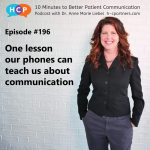A close look at some of the ways we use our phones to communicate can teach us how to improve our communication in general.

Need a break from the news? Today, I’m going to ask you to think about your phone. If you care about communication, and I think you do, considering the ways we communicate with our phones can teach us a lot about how we communicate in general. And that’s what today’s episode is about. I want to introduce you to a scholar, and to a term, that could be helpful in the way you think about your communication.
Hi everybody, this is 10 Minutes to Better Patient Communication, ranked #20 in the top 100 podcasts in social sciences. giving you inspiration and strategies to improve engagement, experience, and satisfaction since 2017. I’m Dr. Anne Marie Liebel, a researcher, consultant, and educator with expertise in communication and education. I’m here to dig into some of what we might take for granted about communication in our professional lives. If you want to strengthen the work you can do in your professional sphere, this is a place for you, because communication touches everything. We’re here to learn, get inspired, and most importantly, make the difference we got into our jobs to make.
So today’s episode is about a concept called “multimodality” and it’s kind of a mouthful. I was made aware of the work of Professor Gunter Kress when I was in graduate school. Gunter Kress was Professor of Semiotics and Education at the Institute of Education at the University of London, and he was a leading contemporary voice in language studies. Professor Kress died a number of years ago, and that’s when I decided to do an episode on some of his work in multimodality. So let’s listen to that episode now.
Generally speaking, a mode, in language and literacy terms, is a way that meaning is communicated. Examples of modes include speech, written text, images, signs, etc. I have a link to a video of Kress answering the question, What’s a mode? Any work that combines more than one mode is called ‘multimodal.’ For instance, think of how videos combine images and sound. Those are two different modes. Videos are, by nature, multimodal, whereas a photograph is monomodal.
It might be easier to understand multimodality if we consider what it’s not. Kress and his collaborator Theo van Leeuven point out that Western culture has historically preferred monomodality, writing:
The most highly valued genres of writing (literary novels, academic treatises, official documents and reports, etc.) came entirely without illustration, and had graphically uniform, dense pages of print. Painting nearly all used the same support (canvas) and the same medium (oils), whatever their style or subject. (Multimodal Discourse p.1)
Hmm…“graphically uniform, dense pages of print,” that are “entirely without illustration?” This makes me think of some discharge instructions I saw once. Anyhow…moving on. They describe how, as monomodality gave way to multimodality, it was still a monomodal scene for a while. This is because even though multimodal works were being made, it was a team effort, made by a group where each person was responsible for one mode. Everyone a specialist. For a newspaper story, for example, you have a writer, a designer, a data visualizer, etc. They’re acting in ensemble to make the newspaper article. Such works “were produced in this way, with different, hierarchically organized specialists in charge of the different modes, and an editing process bringing their work together.” (p. 2)
Certainly, this still happens. But now with digital media, the different modes “can be operated by one multi-skilled person, using one interface…so that he or she can ask at every point: ‘Shall I express this with sound or music?’ ‘Shall I say this visually or verbally?’ and so on.” (Those excerpts are from Kress & van Leeuven’s Multimodal Discourse and links are in the show notes here.) Simply because we’re alive in the 21st century, we all consume– and often produce–complex multimodal texts. Any work with more than one mode, more than one way of making meaning. If you’ve ever shot a video or added images to text, you’ve produced a multimodal work. That is to say, because of digital communication, we can all do multimodal work. The same is true for your patients.
Because of the rapid pace of technology, the expensive design suites that were once only owned and operated by specialists, are now available to all of us. And they’re on our cell phones! Think about all the multimodal work you can consume and produce with a cellphone. Emojis are added to text messages, images are modified with color and shape, videos are shot, edited, viewed, shared, social media is scanned and updated. For more examples, ask the nearest 10-year old. Multimodal communication is true of all of us. Including your patients.
Why is this good news? Because it invites us to reconsider what assumption we are making about the interpretational resources and practices of our audiences. So I’ll invite you to consider: what you are assuming about what your patient reads and writes, or produces and consumes? How is this shaping the way you are interacting with them? Your patients are likely making and interpreting multimodal work (maybe on their cell phone). Rather than worrying about a patient’s educational level or low score on some assessment, focus on the ways they are producers and consumers of multimodal works.
Multimodality is also good news for you in your practice. This is because it helps you focus on the parts of health literacy you can actually do something about. The in-person conversations you have with patients. Any digital patient communication. Any materials shared with patients. In short, multimodality invites you to think about any way words and images are used before, during, and after the patient encounter. What can you do with this cool new information when it comes to communicating with your patients–and the ways they communicate with you? Here’s three ideas to get you started:
1. As I’ve said before, one of the most powerful ways you can help patients learn is through mixing your modes.
This can be simple and unfussy. For example, take a written text you use frequently. Read it aloud–the voice recorder on your phone works just fine–turn it into an audio file. Post the audio file on your website. You only have to do this once, to help many patients. They can read the text, listen to the audio file, or both.
2. How long has it been since you looked at the written materials you give to patients?
Make sure written materials are accompanied by images, and broken up into small paragraphs. Everyone finds this more manageable and memorable.
3. Apps are nearly always multimodal.
They are also interactive. Both of these traits are beneficial for learning. Apps can also be less intimidating than pages of solid prose.
I’ll challenge you to consider any communication as multimodal. Kress and van Leeuven warn us that pretending that language “is the central means of representing and communicating…is simply no longer tenable, that it never really was, and certainly is not now.” (p. 111) So pull on those other modes! Think: images, layout, color, motion, sound.
You and I are both trying to reach people, and I invite you to join me in using multiple modes. This has been 10 Minutes to Better Patient Communication from Health Communication Partners. Audio engineering and music from Joe Liebel, additional music from Alexis Rounds. I’m Dr. Anne Marie Liebel, Thank you for listening.

